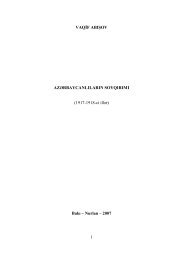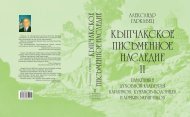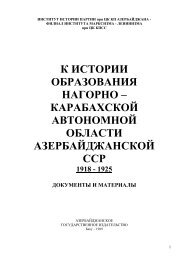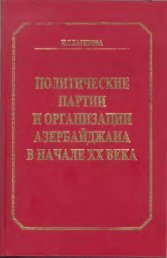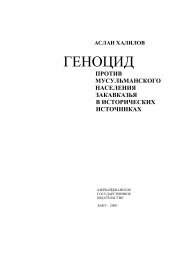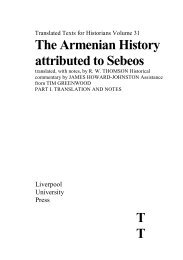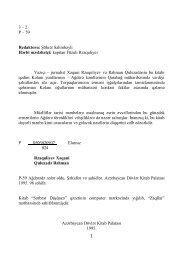ARMENIAN - Erevangala500
ARMENIAN - Erevangala500
ARMENIAN - Erevangala500
Create successful ePaper yourself
Turn your PDF publications into a flip-book with our unique Google optimized e-Paper software.
The Beginning of the End -<br />
The Formation of a Protestant Armenian Millet<br />
In 1846, the curtain came down twice on the Armenians,<br />
both literally and figuratively. In the church of the Armenian<br />
Orthodox Patriarchate in Constantinople, with the<br />
curtains drawn and the altar covered, the patriarch read<br />
an excommunication order against the Armenians who<br />
had converted to Protestantism. They were accused of -<br />
and threatened with - every kind of evil in the world.<br />
Afterwards, the excommunication edict was read in all<br />
the Armenian Orthodox churches in the land under the<br />
same kind of theatrical circumstances.<br />
The great powers rushed to the aid of the Protestant<br />
Armenians, who had now been stripped of all their<br />
rights. England was especially eager to help because it<br />
saw the situation as a good opportunity for intervention.<br />
Finally, the grand vezir o f the Ottoman Empire was<br />
forced to act. On July 1, 1846, a new millet was created<br />
in the Ottoman Empire - the "First Evangelical Armenian<br />
Church". In 1848, the grand vezir published an imperial<br />
"firman" (proclamation) concerning this matter, and two<br />
years later the Sultan personally granted a charter to his<br />
new Protestant millet. Now the Protestant Armenians<br />
had the right to elect their own representatives, who<br />
could then present their concerns to the Sublime Porte<br />
with the same rights as the representatives of the<br />
Orthodox Church.<br />
In the beginning, the new era looked promising. The intentions<br />
o f the Protestant missionaries had undoubtedly<br />
been good, and they had shown unprecedented courage<br />
and selfless devotion. Nevertheless, the outcome was<br />
unintentionally disastrous for the Armenians o f the Ottoman<br />
Empire.<br />
The Catholic Armenians<br />
With the establishment o f the Protestant millet, a three-<br />
way struggle began for the hearts of the Ottoman Armenians.<br />
First, there was the old, established "Gregorian"<br />
Church, which still referred back to its founding by St.<br />
Gregory the Illuminator. Next came the Protestant<br />
Church, officially established in 1850, and thirdly the Armenian<br />
Catholic community of the Ottoman Empire, although<br />
the latter must admittedly be measured on a different<br />
scale. While the Protestants owed their official acceptance<br />
to English (and to a lesser extent American) intervention,<br />
the establishment of the Catholic Armenian<br />
millet was a result of the intervention o f the French, who<br />
had always seen themselves as the protectors of Catholics<br />
living in the East.<br />
The first Catholic Armenian patriarch Flagop Chukurian<br />
was recognized by the Sultan in 1831. It is significant that<br />
his first residence was in Adana, in the precincts of the<br />
former Armenian kingdom o f Cilicia, which had ceased<br />
to exist centuries before.<br />
Armenians had been living in Cilicia ever since an ambitious<br />
relocation program carried out by the Byzantines in<br />
the wake of several Byzantine victories over the Arabs.<br />
The Fletums and the Rubens were the most important<br />
Armenian families among those relocated, and they produced<br />
the leaders of Cilicia. In 1080, the Rubens felt that<br />
they were strong enough to establish a separate principality,<br />
independent of the Byzantines. "Armenian Cilicia"<br />
existed as a wholly or at least partially independent<br />
principality until the year 1375, when the Mamluks<br />
brought it to an end.<br />
The Armenian leaders o f Cilicia were o f course always<br />
looking for allies positioned behind their immediate<br />
One of the most important, outstanding individuals in the Armenian<br />
millet was Mekhitar of Sebaste (of Sivas in central<br />
Anatolia). He was born on February 7, 1676, the son of Armenian<br />
merchants. He soon came in contact with Jesuit missionaries,<br />
"Franks", who relied heavily on Frankish-Armenian relations<br />
established at the time of the Crusades in their missionary work<br />
among the Armenians. Mekhitar became one of the greatest of<br />
Ottoman-Armenian scholars. He founded a congregation and is<br />
considered responsible for the renaissance of Armenian literature.<br />
His mercyless enemy: the Gregorian church.<br />
39



